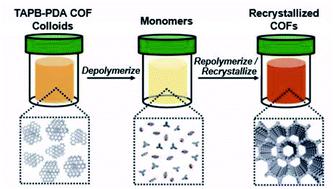当前位置:
X-MOL 学术
›
Chem. Sci.
›
论文详情
Our official English website, www.x-mol.net, welcomes your feedback! (Note: you will need to create a separate account there.)
Solvothermal depolymerization and recrystallization of imine-linked two-dimensional covalent organic frameworks
Chemical Science ( IF 8.4 ) Pub Date : 2021-11-16 , DOI: 10.1039/d1sc03963f Woojung Ji 1 , Leslie S Hamachi 1, 2 , Anusree Natraj 1 , Nathan C Flanders 1 , Rebecca L Li 1 , Lin X Chen 1, 3 , William R Dichtel 1
Chemical Science ( IF 8.4 ) Pub Date : 2021-11-16 , DOI: 10.1039/d1sc03963f Woojung Ji 1 , Leslie S Hamachi 1, 2 , Anusree Natraj 1 , Nathan C Flanders 1 , Rebecca L Li 1 , Lin X Chen 1, 3 , William R Dichtel 1
Affiliation

|
Mechanistic understanding into the formation and growth of imine-linked two-dimensional (2D) covalent organic frameworks (COFs) is needed to improve their materials quality and access larger crystallite sizes, both of which limit the promise of 2D COFs and 2D polymerization techniques. Here we report a previously unknown temperature-dependent depolymerization of colloidal 2D imine-linked COFs, which offers a new means to improve their crystallinity. 2D COF colloids form at room temperature but then depolymerize when their reaction mixtures are heated to 90 °C. As the solutions are cooled back to room temperature, the 2D COFs repolymerize and crystallize with improved crystallinity and porosity, as characterized by X-ray diffraction, infrared spectroscopy and N2 porosimetry. The evolution of COF crystallinity during the solvothermal depolymerization and repolymerization processes was characterized by in situ wide angle X-ray scattering, and the concentrations of free COF monomers as a function of temperature were quantified by variable temperature 1H NMR spectroscopy. The ability of a 2D COF to depolymerize under these conditions depends on both the identity of the COF and its initial materials quality. For one network formed at room temperature (TAPB-PDA COF), a first depolymerization process is nearly complete, and the repolymerization yields materials with dramatically enhanced crystallinity and surface area. Already recrystallized materials partially depolymerize upon heating their reaction mixtures a second time. A related 2D COF (TAPB-DMTA COF) forms initially with improved crystallinity compared to TAPB-PDA COF and then partially depolymerizes upon heating. These results suggest that both high materials quality and network-dependent properties, such as interlayer interaction strength, influence the extent to which 2D COFs resist depolymerization. These findings offer a new means to recrystallize or solvent anneal 2D COFs and may ultimately inform crystallization conditions for obtaining large-area imine-linked two-dimensional polymers from solution.
中文翻译:

亚胺连接的二维共价有机骨架的溶剂热解聚和重结晶
需要对亚胺连接的二维 (2D) 共价有机骨架 (COF) 的形成和生长进行机理理解,以提高其材料质量并获得更大的微晶尺寸,这两者都限制了 2D COF 和 2D 聚合技术的前景。在这里,我们报告了胶体二维亚胺连接的 COF 的先前未知的温度依赖性解聚,这提供了一种提高其结晶度的新方法。2D COF 胶体在室温下形成,但当它们的反应混合物加热到 90 °C 时会解聚。随着溶液冷却回室温,2D COF 重新聚合并结晶,结晶度和孔隙率得到改善,如 X 射线衍射、红外光谱和 N 2所表征的孔隙率测定法。溶剂热解聚和再聚合过程中 COF 结晶度的演变以原位广角 X 射线散射为特征,而作为温度函数的游离 COF 单体浓度通过变温1 H NMR 光谱进行量化。2D COF 在这些条件下解聚的能力取决于 COF 的特性及其初始材料质量。对于在室温下形成的一个网络 ( TAPB-PDA COF),第一个解聚过程几乎完成,再聚合产生的材料具有显着提高的结晶度和表面积。已经重结晶的材料在第二次加热它们的反应混合物时会部分解聚。与TAPB-PDA COF相比,最初形成的相关 2D COF ( TAPB-DMTA COF ) 具有更高的结晶度然后在加热时部分解聚。这些结果表明,高材料质量和网络相关特性(例如层间相互作用强度)都会影响 2D COF 抵抗解聚的程度。这些发现提供了一种重结晶或溶剂退火二维 COF 的新方法,并可能最终为从溶液中获得大面积亚胺连接的二维聚合物的结晶条件提供信息。
更新日期:2021-12-01
中文翻译:

亚胺连接的二维共价有机骨架的溶剂热解聚和重结晶
需要对亚胺连接的二维 (2D) 共价有机骨架 (COF) 的形成和生长进行机理理解,以提高其材料质量并获得更大的微晶尺寸,这两者都限制了 2D COF 和 2D 聚合技术的前景。在这里,我们报告了胶体二维亚胺连接的 COF 的先前未知的温度依赖性解聚,这提供了一种提高其结晶度的新方法。2D COF 胶体在室温下形成,但当它们的反应混合物加热到 90 °C 时会解聚。随着溶液冷却回室温,2D COF 重新聚合并结晶,结晶度和孔隙率得到改善,如 X 射线衍射、红外光谱和 N 2所表征的孔隙率测定法。溶剂热解聚和再聚合过程中 COF 结晶度的演变以原位广角 X 射线散射为特征,而作为温度函数的游离 COF 单体浓度通过变温1 H NMR 光谱进行量化。2D COF 在这些条件下解聚的能力取决于 COF 的特性及其初始材料质量。对于在室温下形成的一个网络 ( TAPB-PDA COF),第一个解聚过程几乎完成,再聚合产生的材料具有显着提高的结晶度和表面积。已经重结晶的材料在第二次加热它们的反应混合物时会部分解聚。与TAPB-PDA COF相比,最初形成的相关 2D COF ( TAPB-DMTA COF ) 具有更高的结晶度然后在加热时部分解聚。这些结果表明,高材料质量和网络相关特性(例如层间相互作用强度)都会影响 2D COF 抵抗解聚的程度。这些发现提供了一种重结晶或溶剂退火二维 COF 的新方法,并可能最终为从溶液中获得大面积亚胺连接的二维聚合物的结晶条件提供信息。



























 京公网安备 11010802027423号
京公网安备 11010802027423号